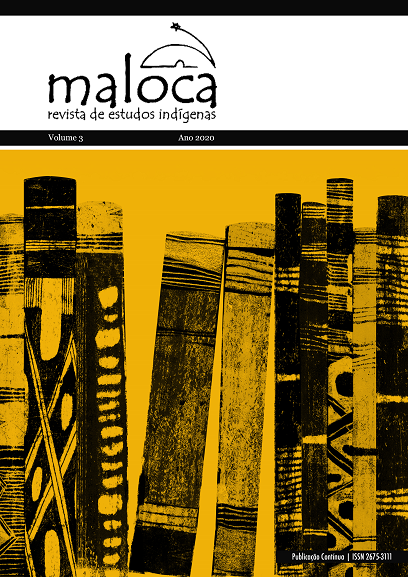Abstract
Although most Jivaroan Indians no longer dress in a traditional way, many of them still insist on wearing face painting. The aim of this article is to explain the reasons for the persistence of this practice, by relating body painting to the construction of a certain form of identity. The author shows that the painted motifs index a complex relational figure that ritually condenses two sorts of agonistic rapport: that between a man and his equals (i.e., other adult male Jivaro), and that between a live male human and a dead person encountered in the course of a drug-induced vision quest. This configuration forms the basis for a type of sharply individualised and highly confrontational selfhood that is held to be specifically Jivaroan.
References
ALBERT, Bruce. Temps du sang, temps des cendres. Représentation de la maladie, système rituel et espace politique chez les Yanomami du sud-est (Amazonie brésilienne). Nanterre, Université Paris X, thèse de 3e cycle, 1985.
ALLIONI, Miguel. El pueblo Shuar. Los Salesianos y la Amazonia. In J. Bottasso (Ed.). Los
Salesianos y la Amazonia. Volumen 2. Quito: Abya-Yala, 1993. p. 25-162.
BATESON, Gregory. Naven. A Survey of the Problems Suggested by a Composite Picture of the Culture of a New Guinea Tribe Drawn from Three Points of View. Londres: Cambridge University Press, 1936.
BIANCHI, Cesare, et. al. Artesanias y técnicas shuar. Sucua: Mundo Shuar, 1982.
CHINKIM, L. et al. El Tigre y la Anaconda. Quito: Abya-Yala, 1987.
ERIKSON, Philippe. La griffe des aïeux. Marquage du corps et démarquages ethniques chez les Matis d’Amazonie. Paris: Peters, 1996.
HOUSEMAN, Michael. The Interdependence of Concealed and Avowed Secrecy: The Interactive Basis of Ritual Effectiveness in a Male Initiation Rite. In: Pascal Boyer (Ed.). Cognitive Aspects of Religious Symbolism. Cambridge: Cambridge University Press, 1993, p. 207-224.
HOUSEMAN, Michael; SEVERI, Carlo. Naven ou le donner à voir. Essai d’interprétation de l’action rituelle. Paris: CNRS Éditions, Éditions de la Maison des sciences
de l’homme, 1994.
HOUSEMAN, Michael; SEVERI, Carlo. Naven or the Other Self: A Relational Approach to Ritual Action. Leiden: Brill,1998.
JUNCOSA, José E. Etnografía de la comunicación verbal shuar. Quito: Abya-Yala, 2000.
KARSTEN, Rafael. The Head-Hunters of Western Amazonas: The Life and Culture of the Jibaro Indians of Eastern Ecuador and Peru. Helsinki: Societas Scientarum Fennica, 1935.
LÉVI-STRAUSS, Claude. Tristes tropiques. Paris: Plon, 1955.
MADER, Elke. Metamorfosis del Poder. Persona, mito y visión en la sociedad Shuar y Achuar (Ecuador, Peru). Quito: Abya-Yala, 1999.
PELLIZZARO, Siro.Técnicas y estructuras familiares de los Shuar. In: BOTTASSO, J. (Ed.). Los Salesianos y la Amazonia. Volumen 2. Quito: Abya-Yala, 1993. p. 247-324.
SEEGER, Anthony. O significado dos ornamentos corporais. In: BENZAQUEN DE ARAÚJO, R. (Ed.). Os Índios e Nós : Estudos sobre Sociedades Tribais Brasileiras. Rio de Janeiro, Editora Campus, 1980. p. 43-60.
SEEGER, Anthony. Nature and Society in Central Brazil: The Suyá Indians of Mato Grosso. Cambridge: Harvard University Press, 1981.
SURRALLÉS, Alexandre. Au coeur du sens. Objectivation et subjectivation chez les Candoshi de l’Amazonie péruvienne. Paris: École des hautes études en sciences sociales, thèse de doctorat, 1999.
TAYLOR, Anne-Christine. Cette atroce république de la forêt… Les origines du paradigme jivaro. Gradhiva v. 3, p. 3-10, 1983.
TAYLOR, Anne-Christine. Les bons ennemis et les mauvais parents. Le traitement de l’alliance dans les rituels de chasse aux têtes des Shuar (Jivaro) de l’Équateur. In: COPPET-ROUGER, Élisabeth; HÉRITIER-AUGÉ, Françoise (Eds.). Les Complexités de l’alliance. IV. Économie, politiques et fondements symboliques. Paris: Éditions des Archives contemporaines, 1993a. p. 73-105.
TAYLOR, Anne-Christine. Remembering to Forget. Jivaroan Ideas of Identity and Mortality. Man, n.s, vol. 28, núm 4, p. 653-678, 1993b.
TAYLOR, Anne-Christine. Le sexe de la proie. Représentations jivaro du lien de parenté. L’Homme vol. 154-
, p. 309-336, 2000.
TURNER, Terence. Social Body and Embodied Subject: Bodiliness, Subjectivity, and Sociality among the Kayapo. Cultural Anthropology, vol. 10, núm. 2, p. 143-170, 1992.
ULLOA, A. Kipara. Dibujo y Pintura : dos formas
Embera de representar el mundo. Bogotá: Centro editorial Universidad Nacional de Colombia, 1992
VERSWIJVER, Gustaf. The Club-Fighters of the Amazon. Warfare among the Kayapo Indians of Central Brazil. Gent: Rijksuniversiteit te Gent, 1992.
VIDAL, Lux. Contribution to the Concept of Person and Self in Lowland South America : Body Painting among the Kayapo-Xikrin. In: Contribuições à Antropologia em Homenagem
ao Professor Egon Schaden. São Paulo: Museu Paulista, Coleção Museu Paulista, Série Ensaios, 1981. p. 291-302.
VIDAL, Lux. (Ed). Grafismo Indígena. São Paulo: Studio Nobel, Fapesp, Edusp. 1992
VILAÇA, Aparecida. Comendo como gente: formas do canibalismo wari’. Rio de Janeiro: Editora UFRJ, 1992.
VIVEIROS DE CASTRO, Eduardo B. From the Enemy’s Point of View: Humanity and Divinity in an Amazonian Society. Chicago: University of Chicago Press, 1992.
VIVEIROS DE CASTRO, Eduardo B. Le meurtrier et son double chez les Araweté (Brésil) : un exemple de fusion rituelle. Systèmes de Pensée en Afrique Noire 14: Destins de meurtriers, 1996, p. 77–104.
WIERHACKE, G. Cultura Material Shuar en la Historia: Estudio de las fuentes del siglo XVI al XIX. Quito: Abya Yala, 1985.

This work is licensed under a Creative Commons Attribution-NonCommercial-ShareAlike 4.0 International License.
Copyright (c) 2020 Anne-Christine Taylor

